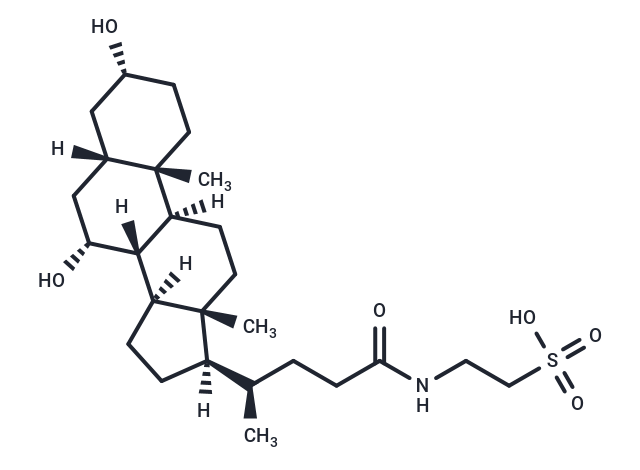Shopping Cart
- Remove All
 Your shopping cart is currently empty
Your shopping cart is currently empty

Taurochenodeoxycholic Acid (12-Deoxycholyltaurine) is one of the main bioactive substances of animals' bile acid.

| Pack Size | Price | Availability | Quantity |
|---|---|---|---|
| 25 mg | $39 | In Stock | |
| 50 mg | $59 | In Stock | |
| 100 mg | $89 | In Stock | |
| 200 mg | $128 | In Stock | |
| 500 mg | $219 | In Stock | |
| 1 mL x 10 mM (in DMSO) | $34 | In Stock |
| Description | Taurochenodeoxycholic Acid (12-Deoxycholyltaurine) is one of the main bioactive substances of animals' bile acid. |
| In vitro | Studies have suggested that taurochenodeoxycholic acid as a signaling molecule shows obvious anti-inflammatory and immune regulation properties. Taurochenodeoxycholic acid dramatically improves the apoptosis rate of NR8383 cells in a concentration-dependent manner. In the meantime, PKC mRNA levels and activities are significantly augmented by taurochenodeoxycholic acid treatments. In addition, JNK, caspase-3 and caspase-8 mRNA expression levels and activities are increased by taurochenodeoxycholic acid. |
| In vivo | Taurochenodeoxycholic acid significantly normalizes the clinical inflammatory parameters, prevented indomethacin-induced increases in the biliary contents of secondary bile acids and hydrophobicity index, and tended to attenuate the intestinal inflammation. Taurochenodeoxycholic acid significantly suppresses paw swelling and polyarthritis index, increases the loss body weight and index of thymus and spleen, and amends radiologic changes in AA rats. The overproduction and mRNA expression of TNF-α, IL-1β and IL-6 are remarkably suppressed in serum and synovium tissue of all TCDCA-treated rats.Taurochenodeoxycholic acid in dosages of 0.05 and 0.1g/kg can decrease the pulmonary coefficient in the model mice, taurochenodeoxycholic acid in dosages of 0.05 and 0.1g/kg reduce the pathological damages on their lungs; it can decrease the expression levels of TNF-α and TIMP-2 in pulmonary tissues in the pulmonary fibrosis mice, the expression level of MMP-9 increases, while it has no significant effects on MMP2. |
| Alias | TCDCA, Taurochenodeoxycholate, Chenyltaurine, Chenodeoxycholyltaurine, 12-Deoxycholyltaurine |
| Molecular Weight | 499.7 |
| Formula | C26H45NO6S |
| Cas No. | 516-35-8 |
| Smiles | C[C@@]12[C@]([C@]3([C@@]([C@]4(C)[C@](C[C@H]3O)(C[C@H](O)CC4)[H])(CC1)[H])[H])(CC[C@@]2([C@@H](CCC(NCCS(=O)(=O)O)=O)C)[H])[H] |
| Relative Density. | 1.216 g/cm3 (Predicted) |
| Storage | Powder: -20°C for 3 years | In solvent: -80°C for 1 year | Shipping with blue ice/Shipping at ambient temperature. | |||||||||||||||||||||||||||||||||||
| Solubility Information | H2O: 100 mg/mL (200.12 mM), Sonication is recommended. DMSO: 50 mg/mL (100.06 mM), Sonication is recommended. | |||||||||||||||||||||||||||||||||||
Solution Preparation Table | ||||||||||||||||||||||||||||||||||||
DMSO/H2O
| ||||||||||||||||||||||||||||||||||||

Copyright © 2015-2025 TargetMol Chemicals Inc. All Rights Reserved.